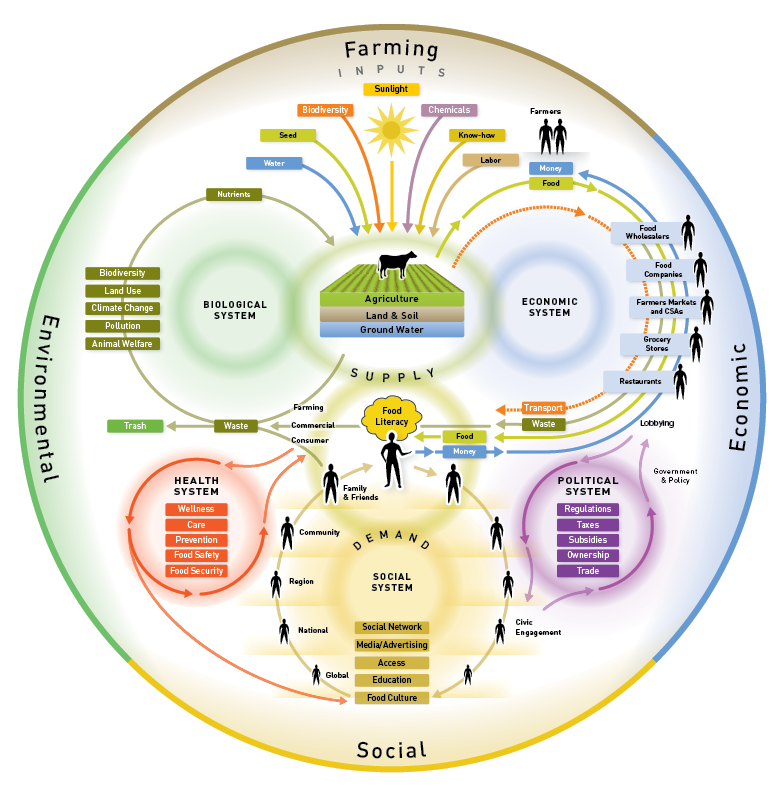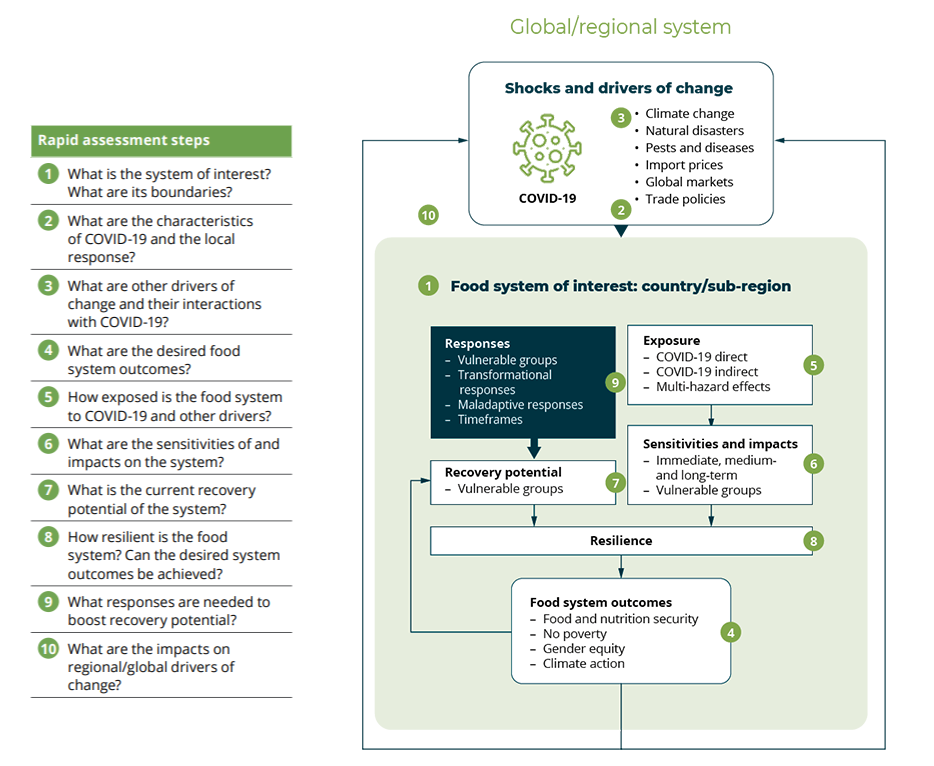The research adopts Allen and Prosperi’s (2016) conceptual approach, which assessed the vulnerability and sustainability of food production in the Mediterranean ‘Latin Arc’. Their framework analysed a food system as a complex social–ecological system and assessed its resilience to global environmental and socioeconomic drivers. The food system is geographically specified, usually at the national or subnational level, with a set of intrinsic endogenous features (exposure, sensitivity, recovery potential and resilience) that determine outcomes in terms of food and nutrition security. The system is impacted by exogenous variables or drivers of change, emanating from the broader regional or global scale. It is assumed to be a ‘driver-taker’, although there are feedbacks from food system outcomes to these higher-scale drivers. To execute the analysis, Allen and Prosperi (2016) outline a four-step process:
- defining the scale of analysis
- identifying drivers of change
- identifying food system outcomes
- examining exposure, sensitivity, impacts and recovery potential.
The results inform a subsequent detailed analysis of emergent issues.
This analytical framework suited the assessment approach for this research for five reasons:
- The national or subnational level of analysis provided a geographically bounded food system.
- COVID-19 represented a clear exogenous, global shock to the system.
- It was possible to investigate COVID-19’s coincidental interactions with other drivers and shocks (for example, climate disasters, pest incursions) that created multiple hazards for the system.
- The stepped process provided a clear and logical line of inquiry that could establish a research method for a rapid assessment.
- The step assessing recovery potential leant itself to identifying priority opportunities to support future resilience.
To apply the framework, Allen and Prosperi’s four steps were expanded to 10 steps (Figure 2.2, Table 2.1). To incorporate a development perspective, explicit identification of pro-poor food system outcomes was included in Step 4, and analysis of vulnerable groups in Steps 6, 7 and 8. In addition, opportunities for transformation were identified in Step 9. These were defined after Colloff et al (in press) as generally irreversible and fundamentally changed structures and functions of a food system, including norms, goals, values, rules and practices. This step also enabled the assessment teams to screen suggested interventions for potentially maladaptive strategies, which were defined as actions which may increase vulnerability to future change over time, creating path-dependency and foreclosing future options (Barnett & O’Neill 2010, Wise et al 2014).
Note: Pro-poor food system outcomes are examples only
| Step | Question | Guiding notes |
|---|---|---|
|
1 |
What is the system of interest and what are its boundaries? |
Describe the food system, either at national or subnational scales if the national scale is too coarse to capture important socioeconomic, cultural and agroecological diversity. |
|
2 |
What are the characteristics of COVID-19 and the local response? |
Describe the nature of the COVID-19 shock, including the date and mode of entry into the country, its spread and the policy response to the outbreak (e.g. lockdown, social distancing, testing). |
|
3 |
What are the other drivers of change and their interactions with COVID-19? |
Identify other global and/or regional drivers of change that are occurring simultaneously and their interactions with the COVID-19 shock to generate multi-hazard effects. These drivers could be immediate and proximate shocks (e.g. cyclones, pest incursions) or incremental (e.g. sea level rise). |
|
4 |
What are the desired food system outcomes? |
Identify the desired pro-poor food system outcomes. These are probably food and nutrition security, but there could be other specific national or sub-regional policy targets and indicators (e.g. Sustainable Development Goals 1 No Poverty, 2 Zero Hunger, 5 Gender Equity and 13 Climate Action, or associated stunting and non-communicable disease and climate adaptation plans). |
|
5 |
How exposed is the food system to COVID-19 and other drivers? |
Exposure is the first point of contact between the shock and the food system. Following the IPCC (2012), exposure is defined as the elements of the system that are susceptible to adverse effects from the exogenous environmental or sociopolitical stress or shock. This step should consider aspects of the food system that are exposed to COVID-19, both directly and indirectly, and compounding global or regional drivers or shocks identified in Step 3 that create multiple hazards. |
|
6 |
What are the sensitivities and impacts on the food system? |
Sensitivity refers to the potential magnitude of the consequences of exposure to shocks and drivers, and hence impact on the food system (Prosperi et al 2014). This step examines the sensitivities and impacts on the system caused by its exposure to COVID-19, and any interactions with other shocks or drivers identified in Step 5. Impacts could be immediate (up to 12 months), medium-term (1–5 years) or long-term (more than 5 years). Sensitivities and impacts should be disaggregated to identify vulnerable social groups, defined as the characteristics of people and their social, political, economic and environmental context which renders them susceptible to hazards or shocks (Kelly & Adger 2000). |
|
7 |
What is the current recovery potential of the system? |
This step assesses the potential of the system to respond to and absorb disturbances in order to continue to function. Because recovery potential may differ among social groups of interest, the analysis should be disaggregated. |
|
8 |
How resilient is the system and can the desired food system outcomes be achieved? |
Resilience is the net result of impact and recovery potential and should be disaggregated to highlight key issues/groups with major challenges emanating from the shock. This step should also consider whether the desired food system outcomes can be achieved. |
|
9 |
What responses are needed to boost recovery potential? |
This is the primary output of the analysis and identifies responses that will bolster recovery potential to COVID-19 and future shocks or drivers of change. It is informed by the impacts and recovery potential that different social groups exhibit (from Steps 6 and 7), and by food system outcomes (from Step 8) which influence options. Time frames for responses can be categorised as short term (up to 1 year), intermediate-term (up to 5 years) or longer-term (up to 10 years). Transformational actions should be identified and suggested interventions should be screened for potentially maladaptive responses. |
|
10 |
What are the impacts on regional/global drivers of change? |
Allen and Prosperi (2016) consider that the potential economic, social and biophysical feedbacks from the food system to the global or regional drivers and shocks are secondary, since the food system is typically a ‘driver-taker’. However, this step should consider if there are system outcomes that could influence regional drivers (e.g. refugee emigration to other countries or political unrest influencing geopolitics). |

